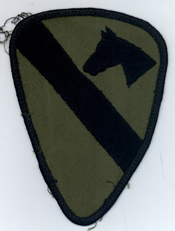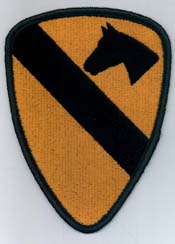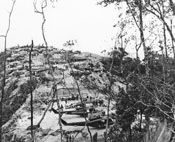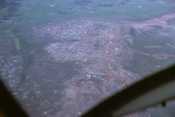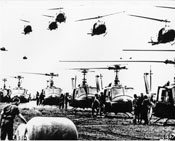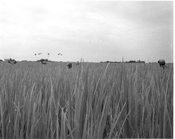Vietnam: The Helicopter War
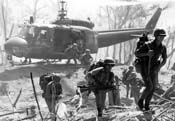
Combat Scenes- ARVN- Helioborne: ; Heavily laden infantrymen of the 1st Battalion, 1st Regiment of ARVN First Division dash from a helicopter which lifted them to a recently "cleared" mountain top landing zone over-looking Ba Long Valley in Quang Tri Province.
Douglas Pike Photograph Collection [VA002367]
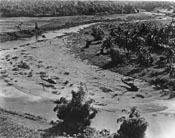
Helicopters of the 119th Assault Helicopter Company near Pleiku in II Corps.
U.S. Army Aviation Museum Volunteer Archivists Collection [VA058912]
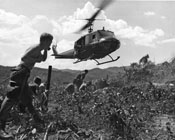
Operation Pershing - A search and destroy operation approximately 50 kilometers northeast of An Khe in Binh Dinh Province.
U.S. Army Aviation Museum Volunteer Archivists Collection [VA059065]
The New Air Cavalry Division
- Troops Disembarking from UH-1 (undated) - [full record]
The 1st Cavalry Division (Airmobile) was the first division ever equipped specifically with helicopters supplying the primary means of troop transport. The 1st Cavalry arrived in Vietnam in 1965 with 428 helicopters at their base camp at An Khe. The newly formed Air Cavalry helped the Army overcome tremendous physical obstacles and developed new tactics to face a guerrilla enemy force.
Ia Drang
The first major test of the Air Cavalry in battle took place 14-17 November 1965 when the 1st Cavalry engaged North Vietnamese troops in the Ia Drang Valley of the Vietnamese Central Highlands. Elements of the 1st Cav were greatly outnumbered by North Vietnamese forces and American helicopter crews braved extreme enemy fire to reinforce the American ground troops. The Battle of Ia Drang demonstrated the effectiveness of the new Air Cavalry approach: fifty-nine helicopters were damaged, but only four were shot down and three of those were recovered in this crucial American victory. Helicopter pilots Maj. Bruce Crandall and Capt. Ed Freeman received the Medal of Honor for their heroic actions in the Ia Drang Valley.
- After Action Report, IA DRANG Valley Operation 1st Battalion, 7th Cavalry 14-16 November 1965 (46 pages) [9 December 1965] [1710101004] - [full record]
- Newspaper Article, Quan Doi Nhan Dan online, and translation - English Title: The Plei Me-Ia Drang Victory (19 Oct to 20 Nov 1965): A Stunning First Blow Against American Troops in the Central Highlands (by: Colonel General Nguyen Nam Khanh) (6 pages) [15 November 2005] [16900101002] - [full record]
- Publication, 1st Cavalry Division Association - Interim Report of Operations, First Cavalry Division, July 1965 to December 1966 (by: Charles Sykes, Jr.) (57 pages) [ca. 1967] [22030101001] - [full record]
- Publication, People's Army Publishing House, Hanoi - English Translation by Merle Pribbenow - 304th Division, Volume II, March-December 1965 (by: Nguyen Huy Toan and Pham Quang Dinh) (122 pages) [1990] [16900105001] - [full record]
- Statement By Col Winkel On Actions As Requested By Command Chain Concerning Actions Of Nov 1965 (11 pages) [14 November 2005] [17070101001] - [full record]
New Tactics for the Air Cavalry
Airmobile Support Network
Traditional base camps were established along with a network of landing zones for delivering troops and fire support bases provided artillery support where it was most needed.
Landing Zones (LZ) could be used long-term, but were frequently an area that was identified and cleared in advance and used temporarily to place ground troops within close distance to their mission area.
Fire Support Bases (FSB or FB) made it possible to maintain artillery support and supplies within useful range of ground units in remote locations often accessible only by helicopter. The FSB was a semi-permanent encampment which could be packed up and relocated as the unites they supported were moved.
Backward Planning of Airmobile Operations
Because the principal goal of air mobility was to place combat rifle units within close distance of their objective, a Reverse Sequence to planning airmobile operations was developed:- Determination of Goal/Objective
- Landing Plan - sequence to put troops on Landing Zone (LZ) in correct order and location
- Air Movement Plan - Sequence to deliver helicopters, troops, equipment and supplies to LZ
- Loading Plan at Pick-Up Zone (PZ) - Sequence for loading of helicopters, troops, equipment and supplies
- Staging Plan - Sequence for arrival of elements at PZ for loading
Team Tactics
New tactics were developed by organizing the helicopters into teams:
- Red Team: Offensive mission with one Huey Gunship and one Cobra Attack Helicopter. Goal is to provide high concentration of firepower on an enemy location.
- White Team: Reconnaissance Mission with two LOACH helicopters: one flying treetop level for observation and one flying high altitude for cover and communication.
- Pink Team: One observation helicopter flying low for reconnaissance and to attract enemy fire, with one gunship flying high to provide cover and call in artillery or Cobra Attack Helicopters.
- Blue Team: Huey Slicks for carrying in a rifle platoon or ground cavalry troops when enemy troops or supply caches are located. These would be accompanied by additional teams for reconnaissance and fire support.
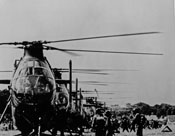
CH-21 helicopters loading troops in Vietnam.
U.S. Army Aviation Museum Volunteer Archivists Collection [VA058857]
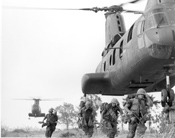
(105) First wave-- Leatherneck helicopter of Marine Medium helicopter of Marine Medium Helicopter Squadron 164 and infantryman of the 2nd Battalion, 5th Marine Regiment, are the first elements into the zine, November 20 during Operation Mead River, about eight miles southwest of Danang. More than 75 helicopters of the 1st Marine Aircraft Wing lifted some 3,500 leathernecks into pre-designed zones in approximately two hours.
Brigadier General Edwin H. Simmons Collection [VA020938]
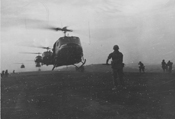
FSB DRAGON, Vietnam (Americal IO)--A combined team of Regional and Popular Forces, National Police Field Forces, and Recon, 1st Battalion, 20th Infantry, prepare to board helicopters seven miles morthwest of Duc Pho for a combat assault in Americal Division territory.
Americal Division Veterans Association Collection Americal Division Veterans Association [VA050772]
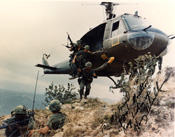
Operation Oregon, a search and destory mission conducted by an infantry platoon of Troop B, 1st Recon Sqd, 9th Cav, 1st Cav Div, three kilometers west of Duc Pho, Quang Nhai Province. Members of the reconnaisance platoon are dispatched from a helicopter hovering above the ridge line.
Paul L. Moulton Collection Department of the Army Special Photographic Office (DASPO) [VA055897]
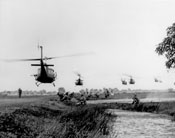
UH-1D helicopters. - Helicopters depart after taking on a load of troops. Location: Cat Lay, Vietnam. Photographer: J. Hesselgrave
U.S. Army Aviation Museum Volunteer Archivists Collection [VA058768]
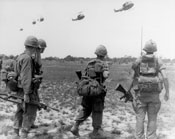
UH-1 Helicopter. Troops wait to be picked up after mission in Long Thanh area, east of Saigon. Photographer: Allan Holm
U.S. Army Aviation Museum Volunteer Archivists Collection [VA058769]
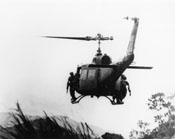
UH-1 helicopter makes aerial delivery of personnel.
U.S. Army Aviation Museum Volunteer Archivists Collection [VA058770]
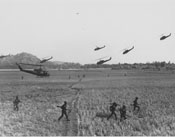
Landing Zone - Insertion of Troops
U.S. Army Aviation Museum Volunteer Archivists Collection [VA059095]
Bibliography
- Dunstan, Simon. Vietnam Choppers (Revised Edition): Helicopters in Battle 1950-1975. Oxford, United Kingdom: Osprey Publishing, 2003.
- Stanton, Shelby. The 1st Cav in Vietnam: Anatomy of a Division. New York, New York: Ballantine Books, 2003.
- Dunstan, Simon. 1st Air Cavalry in Vietnam: The 'First Team.' Surrey, United Kingdom: Ian Allan Publishing, 2004.
- Mesko, Jim. Airmobile: The Helicopter War in Vietnam (Vietnam Studies Group series, 6040). Squadron/Signal Publications, 1984.
- Johnson III, Lawrence H. Winger Sabers: The Air Cavalry in Vietnam. Stackpole Books, 2001.
- 1710101004, Operation Masher/Operation White Wing Collection, The Vietnam Center and Sam Johnson Vietnam Archive, Texas Tech University.
- 16900101002, Merle Pribbenow Collection, The Vietnam Center and Sam Johnson Vietnam Archive, Texas Tech University.
- 22440101001, Jim B. Green Collection, The Vietnam Center and Sam Johnson Vietnam Archive, Texas Tech University.
- 22030101001, Richard P. Carmody Collection, The Vietnam Center and Sam Johnson Vietnam Archive, Texas Tech University.
- 16900105001, Merle Pribbenow Collection, The Vietnam Center and Sam Johnson Vietnam Archive, Texas Tech University.
- 21680101001, Frederick L. Spaulding Collection, The Vietnam Center and Sam Johnson Vietnam Archive, Texas Tech University.
- 17070101001, Paul Winkel, Jr. Collection, The Vietnam Center and Sam Johnson Vietnam Archive, Texas Tech University.
- 987VI0648, Michael Sheets Collection, The Vietnam Center and Sam Johnson Vietnam Archive, Texas Tech University.
- 1852VI2284, Hilmar Braun Collection, The Vietnam Center and Sam Johnson Vietnam Archive, Texas Tech University
- OH0486, Ed Freeman Collection, The Vietnam Center and Sam Johnson Vietnam Archive, Texas Tech University
- 1618museum1748, Ralph Reinhart Collection, The Vietnam Center and Sam Johnson Vietnam Archive, Texas Tech University.
- 1926museum3759, John Hauge Collection, The Vietnam Center and Sam Johnson Vietnam Archive, Texas Tech University.
- VA024521, Vietnam Women Veterans Association, The Vietnam Center and Sam Johnson Vietnam Archive, Texas Tech University.
- VA036590, Van Michael Davidson Collection, The Vietnam Center and Sam Johnson Vietnam Archive, Texas Tech University.
- VA050772, Americal Division Veterans Association Collection, The Vietnam Center and Sam Johnson Vietnam Archive, Texas Tech University.
- VA055897, Paul L. Moulton Collection, The Vietnam Center and Sam Johnson Vietnam Archive, Texas Tech University.
- VA058768, U.S. Army Aviation Museum Volunteer Archivists Collection, The Vietnam Center and Sam Johnson Vietnam Archive, Texas Tech University.
- VA058769, U.S. Army Aviation Museum Volunteer Archivists Collection, The Vietnam Center and Sam Johnson Vietnam Archive, Texas Tech University.
- VA058770, U.S. Army Aviation Museum Volunteer Archivists Collection, The Vietnam Center and Sam Johnson Vietnam Archive, Texas Tech University.
- VA058857, U.S. Army Aviation Museum Volunteer Archivists Collection, The Vietnam Center and Sam Johnson Vietnam Archive, Texas Tech University.
- VA058912, U.S. Army Aviation Museum Volunteer Archivists Collection, The Vietnam Center and Sam Johnson Vietnam Archive, Texas Tech University.
- VA058913, U.S. Army Aviation Museum Volunteer Archivists Collection, The Vietnam Center and Sam Johnson Vietnam Archive, Texas Tech University.
- VA059065, U.S. Army Aviation Museum Volunteer Archivists Collection, The Vietnam Center and Sam Johnson Vietnam Archive, Texas Tech University.
- VA059076, U.S. Army Aviation Museum Volunteer Archivists Collection, The Vietnam Center and Sam Johnson Vietnam Archive, Texas Tech University.
- VA059095, U.S. Army Aviation Museum Volunteer Archivists Collection, The Vietnam Center and Sam Johnson Vietnam Archive, Texas Tech University.
- VAS026653, Gary Snead Collection, The Vietnam Center and Sam Johnson Vietnam Archive, Texas Tech University.
Vietnam Center & Sam Johnson Vietnam Archive
-
Address
Texas Tech University, Box 41041, Lubbock, TX 79409 -
Phone
(806)742-9010 -
Email
vnca@ttu.edu


